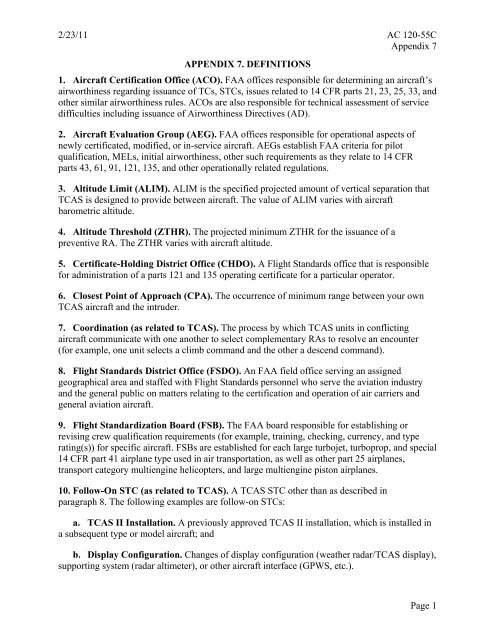AC 120-55C Air Carrier TCAS - Code7700
AC 120-55C Air Carrier TCAS - Code7700
AC 120-55C Air Carrier TCAS - Code7700
Create successful ePaper yourself
Turn your PDF publications into a flip-book with our unique Google optimized e-Paper software.
2/23/11 <strong>AC</strong> <strong>120</strong>-<strong>55C</strong>Appendix 7APPENDIX 7. DEFINITIONS1. <strong>Air</strong>craft Certification Office (<strong>AC</strong>O). FAA offices responsible for determining an aircraft’sairworthiness regarding issuance of TCs, STCs, issues related to 14 CFR parts 21, 23, 25, 33, andother similar airworthiness rules. <strong>AC</strong>Os are also responsible for technical assessment of servicedifficulties including issuance of <strong>Air</strong>worthiness Directives (AD).2. <strong>Air</strong>craft Evaluation Group (AEG). FAA offices responsible for operational aspects ofnewly certificated, modified, or in-service aircraft. AEGs establish FAA criteria for pilotqualification, MELs, initial airworthiness, other such requirements as they relate to 14 CFRparts 43, 61, 91, 121, 135, and other operationally related regulations.3. Altitude Limit (ALIM). ALIM is the specified projected amount of vertical separation that<strong>TCAS</strong> is designed to provide between aircraft. The value of ALIM varies with aircraftbarometric altitude.4. Altitude Threshold (ZTHR). The projected minimum ZTHR for the issuance of apreventive RA. The ZTHR varies with aircraft altitude.5. Certificate-Holding District Office (CHDO). A Flight Standards office that is responsiblefor administration of a parts 121 and 135 operating certificate for a particular operator.6. Closest Point of Approach (CPA). The occurrence of minimum range between your own<strong>TCAS</strong> aircraft and the intruder.7. Coordination (as related to <strong>TCAS</strong>). The process by which <strong>TCAS</strong> units in conflictingaircraft communicate with one another to select complementary RAs to resolve an encounter(for example, one unit selects a climb command and the other a descend command).8. Flight Standards District Office (FSDO). An FAA field office serving an assignedgeographical area and staffed with Flight Standards personnel who serve the aviation industryand the general public on matters relating to the certification and operation of air carriers andgeneral aviation aircraft.9. Flight Standardization Board (FSB). The FAA board responsible for establishing orrevising crew qualification requirements (for example, training, checking, currency, and typerating(s)) for specific aircraft. FSBs are established for each large turbojet, turboprop, and special14 CFR part 41 airplane type used in air transportation, as well as other part 25 airplanes,transport category multiengine helicopters, and large multiengine piston airplanes.10. Follow-On STC (as related to <strong>TCAS</strong>). A <strong>TCAS</strong> STC other than as described inparagraph 8. The following examples are follow-on STCs:a. <strong>TCAS</strong> II Installation. A previously approved <strong>TCAS</strong> II installation, which is installed ina subsequent type or model aircraft; andb. Display Configuration. Changes of display configuration (weather radar/<strong>TCAS</strong> display),supporting system (radar altimeter), or other aircraft interface (GPWS, etc.).Page 1
















